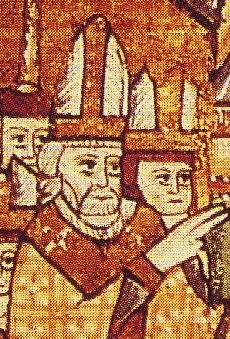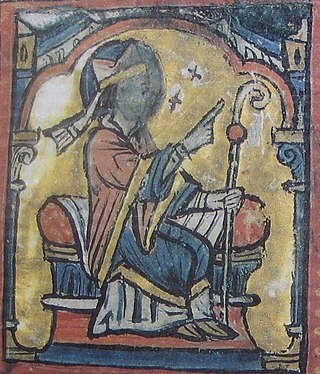
Bruno di Segni was an Italian Roman Catholic prelate and professed member from the Order of Saint Benedict who served as Bishop of Segni and Abbot of Montecassino. He studied under the Benedictines in Bologna before being appointed a canon of the cathedral chapter of Siena. He was invited to Rome where he became a bishop and counselled four consecutive popes. He served as Abbot of Montecassino but when he criticised Pope Paschal II regarding the Concordat of Ponte Mammolo in 1111 the pope relieved him of his duties as abbot and ordered Bruno to return to his diocese, where he died just over a decade later. Bruno's canonization was celebrated on 5 September 1181 under Pope Lucius III who presided over the celebration in the late bishop's diocese.
Henry of Marcy, or Henry de Marsiac, was a Cistercian abbot, first of Hautecombe in Savoy (1160–1177), and then of Clairvaux, from 1177 until 1179. He was created Cardinal Bishop of Albano by Pope Alexander III at the Third Lateran Council in 1179.

Albinus was an Italian Cardinal of the late twelfth century. A native of Milan, or perhaps of Gaeta, he became an Augustinian regular canon.

The 1185 papal election was a convoked after the death of Pope Lucius III. It resulted in the election of Cardinal Uberto Crivelli of Milan, who took the name of Urban III.

The 1088 papal election subsequent to the death of Pope Victor III in 1087 was held on 12 March 1088. Six cardinal-bishops, assisted by two lower-ranking cardinals, elected Cardinal-Bishop of Ostia Odon de Lagery as the new Pope. He assumed the name Urban II.
The October 1187 papal election was convoked after the death of Pope Urban III. He and the papal court had escaped from the imperial blockade of Verona only the month before, and had taken refuge in Ferrara. The election, held in Ferrara the day after the pope's death, resulted in the election of Cardinal Alberto Sartori di Morra, who took the name of Gregory VIII. He was a partisan of the Emperor Frederick Barbarossa, whose election delighted him. Gregory VIII reigned only two months.

The December 1187 papal election was convoked after the death of Pope Gregory VIII. It resulted in the election of Cardinal Paolo Scolari, who took the name of Clement III.
Oderisio di Sangro was an Italian Benedictine monk and cardinal, the son of Count Rinaldo of the family of the conti di Sangro in the Marsi.

The 1191 papal election took place after the death of Pope Clement III. Pope Clement, according to differing and irreconcilable reports, died in March 1191, in the last third of the month, on the 20th, the 25th, the 26th, the 28th, or perhaps 2 April or 4 April, or 10 April. The election was conducted during the march of King Henry VI and his army toward Rome. The 85-year-old Cardinal Giacinto Bobone, a member of the Orsini family, was chosen after some extreme reluctance. He took the name Celestine III. Pressed by the Romans, however, he agreed to negotiate with King Henry about his coronation as emperor and about the possession of the city of Tusculum. Celestine postponed his own consecration in order to buy time to negotiate. He was finally crowned on Easter Sunday, 14 April 1191.

Pietro Diani was an Italian cardinal. The name "Diana" is incorrect; he signs himself Petrus Dianus.
Roscemanno, O.S.B.Cas. was a Roman Catholic Cardinal and Deacon of San Giorgio in Velabro.

Laborans de Pontormo was an Italian cardinal. His name in Italian is Laborante. He was a native of Pontormo, a suburb of the city of Florence on the left bank of the Arno River. He was a distinguished jurist and influential writer on canon law.

Rolandus was a cardinal of the Roman Catholic Church. He was a native of Pisa, not Siena or Brittany. He was elected archbishop of Dol, but was not consecrated for five years, due to the opposition his metropolitan, the archbishop of Tours. Before he became a cardinal, he was sent by Pope Lucius III as his representative to Scotland to attempt to resolve a dispute over episcopal elections, involving the king.

Bobo was a cardinal of the Roman Catholic Church. He was a native of Rome, and a member of the Bobone family, later called the Orsini.

Graziano da Pisa was a cardinal of the Roman Catholic Church. He was a native of Pisa, and the nephew of Pope Eugenius III (1145-1153). He had studied law in Bologna, and held the rank of Magister. He was a prominent official in the papal chancery, and an accomplished papal diplomat.

Ardicio de Rivoltela was a cardinal of the Roman Catholic Church. He was a native of Piadena (Platina), in the diocese of Cremona in Lombardy. The appellation "de Rivoltela" is mentioned only once, and its significance is unclear.
Melior, O.S.B. Vall. was a Benedictine monk, and a cardinal of the Roman Catholic Church. He was a native of Pisa. He served as papal legate in France for more than three years, trying to arrange a peace between Richard I and Philip II. He became a major negotiator, on the mandate of Pope Celestine III, in the divorce case between King Philip II of France and Queen Ingeborg of Denmark.
Theodinus, O.S.B. was a Benedictine monk, and a cardinal of the Roman Catholic Church. He was a native of Arrone, a hilltop town 15 km east of Terni. He became a cardinal priest, and then cardinal bishop of Porto. He served as a papal diplomat, in Normandy, in the Balkans, and in Venice. He participated in the papal elections of 1181 and 1185.

Pietro de Bono was a cardinal of the Roman Catholic Church. He was a native of Verona in Lombardy, signing his name at least once as D. Petri de Verona. He was not from Pisa, nor was he from Bologna. He belonged to the Canons Regular of S. Maria di Reno in Bologna.
Joannes Anagninus was a cardinal of the Roman Catholic Church. He was a native of Anagni, and belonged to the family of the Counts of Anagni, the same family which produced Pope Innocent III. His colleagues called him, and he called himself "Joannes Anagninus". In 1191, he subscribed himself Joannes comes Anagninus, episcopus cardinalis Praenestinus. He was successively cardinal deacon of S. Maria in Portico, cardinal priest of S. Marco, and cardinal bishop of Palestrina.






